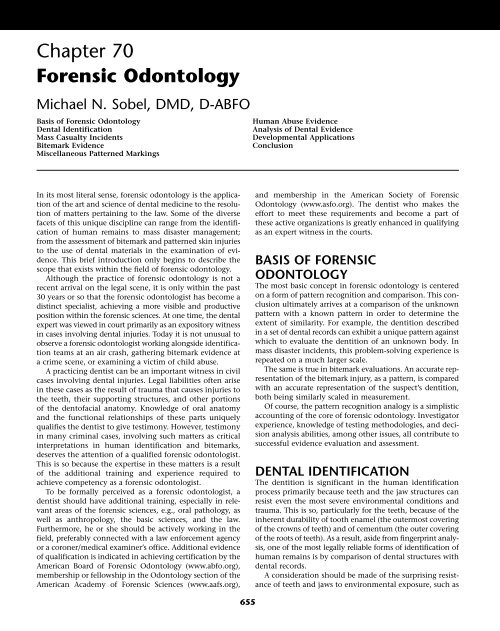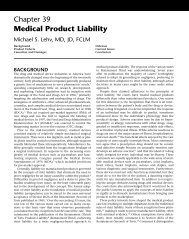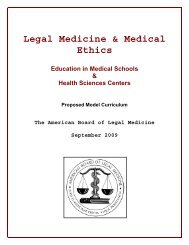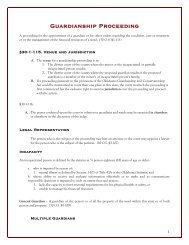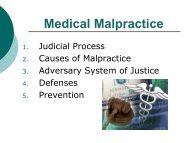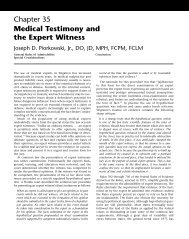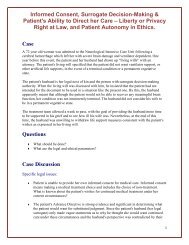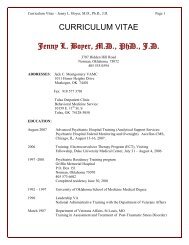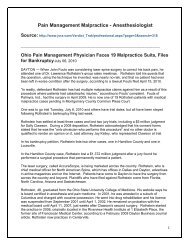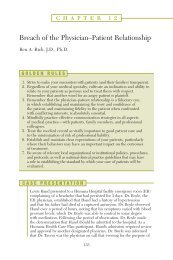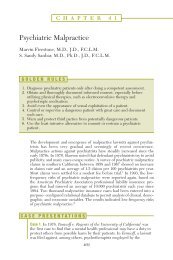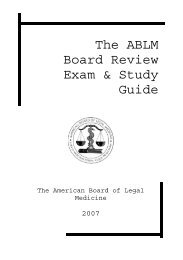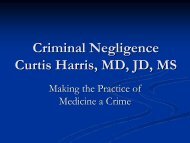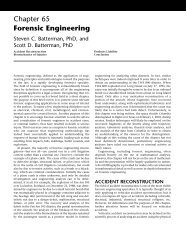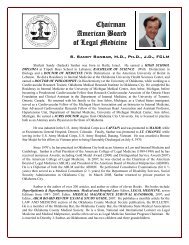Ch70-Forensic Odontology.pdf - Legal Medicine and Medical Ethics ...
Ch70-Forensic Odontology.pdf - Legal Medicine and Medical Ethics ...
Ch70-Forensic Odontology.pdf - Legal Medicine and Medical Ethics ...
Create successful ePaper yourself
Turn your PDF publications into a flip-book with our unique Google optimized e-Paper software.
<strong>Ch70</strong>-A03753 12/15/06 10:41 AM Page 655<br />
Chapter 70<br />
<strong>Forensic</strong> <strong>Odontology</strong><br />
Michael N. Sobel, DMD, D-ABFO<br />
Basis of <strong>Forensic</strong> <strong>Odontology</strong><br />
Dental Identification<br />
Mass Casualty Incidents<br />
Bitemark Evidence<br />
Miscellaneous Patterned Markings<br />
Human Abuse Evidence<br />
Analysis of Dental Evidence<br />
Developmental Applications<br />
Conclusion<br />
In its most literal sense, forensic odontology is the application<br />
of the art <strong>and</strong> science of dental medicine to the resolution<br />
of matters pertaining to the law. Some of the diverse<br />
facets of this unique discipline can range from the identification<br />
of human remains to mass disaster management;<br />
from the assessment of bitemark <strong>and</strong> patterned skin injuries<br />
to the use of dental materials in the examination of evidence.<br />
This brief introduction only begins to describe the<br />
scope that exists within the field of forensic odontology.<br />
Although the practice of forensic odontology is not a<br />
recent arrival on the legal scene, it is only within the past<br />
30 years or so that the forensic odontologist has become a<br />
distinct specialist, achieving a more visible <strong>and</strong> productive<br />
position within the forensic sciences. At one time, the dental<br />
expert was viewed in court primarily as an expository witness<br />
in cases involving dental injuries. Today it is not unusual to<br />
observe a forensic odontologist working alongside identification<br />
teams at an air crash, gathering bitemark evidence at<br />
a crime scene, or examining a victim of child abuse.<br />
A practicing dentist can be an important witness in civil<br />
cases involving dental injuries. <strong>Legal</strong> liabilities often arise<br />
in these cases as the result of trauma that causes injuries to<br />
the teeth, their supporting structures, <strong>and</strong> other portions<br />
of the dentofacial anatomy. Knowledge of oral anatomy<br />
<strong>and</strong> the functional relationships of these parts uniquely<br />
qualifies the dentist to give testimony. However, testimony<br />
in many criminal cases, involving such matters as critical<br />
interpretations in human identification <strong>and</strong> bitemarks,<br />
deserves the attention of a qualified forensic odontologist.<br />
This is so because the expertise in these matters is a result<br />
of the additional training <strong>and</strong> experience required to<br />
achieve competency as a forensic odontologist.<br />
To be formally perceived as a forensic odontologist, a<br />
dentist should have additional training, especially in relevant<br />
areas of the forensic sciences, e.g., oral pathology, as<br />
well as anthropology, the basic sciences, <strong>and</strong> the law.<br />
Furthermore, he or she should be actively working in the<br />
field, preferably connected with a law enforcement agency<br />
or a coroner/medical examiner’s office. Additional evidence<br />
of qualification is indicated in achieving certification by the<br />
American Board of <strong>Forensic</strong> <strong>Odontology</strong> (www.abfo.org),<br />
membership or fellowship in the <strong>Odontology</strong> section of the<br />
American Academy of <strong>Forensic</strong> Sciences (www.aafs.org),<br />
<strong>and</strong> membership in the American Society of <strong>Forensic</strong><br />
<strong>Odontology</strong> (www.asfo.org). The dentist who makes the<br />
effort to meet these requirements <strong>and</strong> become a part of<br />
these active organizations is greatly enhanced in qualifying<br />
as an expert witness in the courts.<br />
BASIS OF FORENSIC<br />
ODONTOLOGY<br />
The most basic concept in forensic odontology is centered<br />
on a form of pattern recognition <strong>and</strong> comparison. This conclusion<br />
ultimately arrives at a comparison of the unknown<br />
pattern with a known pattern in order to determine the<br />
extent of similarity. For example, the dentition described<br />
in a set of dental records can exhibit a unique pattern against<br />
which to evaluate the dentition of an unknown body. In<br />
mass disaster incidents, this problem-solving experience is<br />
repeated on a much larger scale.<br />
The same is true in bitemark evaluations. An accurate representation<br />
of the bitemark injury, as a pattern, is compared<br />
with an accurate representation of the suspect’s dentition,<br />
both being similarly scaled in measurement.<br />
Of course, the pattern recognition analogy is a simplistic<br />
accounting of the core of forensic odontology. Investigator<br />
experience, knowledge of testing methodologies, <strong>and</strong> decision<br />
analysis abilities, among other issues, all contribute to<br />
successful evidence evaluation <strong>and</strong> assessment.<br />
DENTAL IDENTIFICATION<br />
The dentition is significant in the human identification<br />
process primarily because teeth <strong>and</strong> the jaw structures can<br />
resist even the most severe environmental conditions <strong>and</strong><br />
trauma. This is so, particularly for the teeth, because of the<br />
inherent durability of tooth enamel (the outermost covering<br />
of the crowns of teeth) <strong>and</strong> of cementum (the outer covering<br />
of the roots of teeth). As a result, aside from fingerprint analysis,<br />
one of the most legally reliable forms of identification of<br />
human remains is by comparison of dental structures with<br />
dental records.<br />
A consideration should be made of the surprising resistance<br />
of teeth <strong>and</strong> jaws to environmental exposure, such as<br />
655
<strong>Ch70</strong>-A03753 12/15/06 10:41 AM Page 656<br />
656 <strong>Forensic</strong> <strong>Odontology</strong><br />
even the most severe fires. The oral cavity seems to be so well<br />
insulated against the high temperature of fires that often<br />
even the supporting tissues surrounding the teeth are also<br />
well preserved. In addition, the dental restorations are<br />
frequently completely intact.<br />
Identification case example 1. A husb<strong>and</strong> suspected his<br />
wife of infidelity. He confronted her in a bar with another man<br />
<strong>and</strong> shot them both. The shooter took off with the police in<br />
pursuit <strong>and</strong> returned to his trailer home. The police surrounded<br />
the trailer <strong>and</strong> his car, <strong>and</strong> the car erupted into<br />
flames. When the fire was extinguished, severely burned<br />
human remains were discovered. In particular, there was a<br />
m<strong>and</strong>ible with only a part of the cranium attached to the<br />
maxilla. The question to be answered: was this the shooter<br />
they were after or was someone else planted in the vehicle<br />
This author examined the skull <strong>and</strong>, finding most of the dentition<br />
was intact, compared the antemortem dental records<br />
with the postmortem remains. There was complete concordance,<br />
including a distinctive gold crown <strong>and</strong> several other<br />
dental restorations, thus confirming the identity of the shooter.<br />
The inherent possibilities for uniqueness in the human<br />
dentition enable the forensic dentist to determine the degree<br />
of concordance between antemortem dental records <strong>and</strong> the<br />
oral structures of specific human remains under examination.<br />
The human adult dentition typically consists of 32<br />
teeth, each with 5 surfaces, thus providing 160 possibilities<br />
for individual variations of surface anatomy <strong>and</strong> dental<br />
restorations in configuration, size, shape, material, <strong>and</strong> wear<br />
patterns. This does not even take into account, <strong>and</strong> is not<br />
limited to, such factors as decay, missing <strong>and</strong> extra teeth,<br />
alignment of the dental arches, individual tooth positioning,<br />
<strong>and</strong> prosthetic appliances. In fact, in the United States<br />
there are many more dental records on file than fingerprint<br />
records. The experienced dental clinician can detect many<br />
subtleties in observable detail of the teeth <strong>and</strong> jaws which<br />
are most useful in confirming a human identification.<br />
Among other distinctive characteristics for antemortem <strong>and</strong><br />
postmortem comparisons are maxillary sinus patterns, bone<br />
trabeculation patterns, <strong>and</strong> orbital outlines.<br />
A question often arises as to the number of points of<br />
concordance necessary to render a valid decision on a dental<br />
identification. However, this is not as significant as the<br />
singular quality, or exclusivity, of the points of comparison<br />
involved. In addition, when all of the points of concordance<br />
in a particular case are considered as a set of aggregate<br />
data, the investigator should be able to state, if<br />
possible, whether the identification is “positive within reasonable<br />
scientific certainty.”<br />
The following categories <strong>and</strong> terminology for body identification<br />
are suggested for use in communicating the<br />
results of a forensic odontology identification investigation:<br />
Positive identification: The antemortem <strong>and</strong> postmortem<br />
data match in sufficient detail to establish that<br />
they are from the same individual. In addition, there are no<br />
irreconcilable discrepancies.<br />
Possible identification: The antemortem <strong>and</strong> postmortem<br />
data have consistent features, but, due to the<br />
quality of either the postmortem remains or the antemortem<br />
evidence, it is not possible to positively establish<br />
dental identification.<br />
Insufficient evidence: The available information is<br />
insufficient to form the basis for a conclusion.<br />
Exclusion: The antemortem <strong>and</strong> postmortem data are<br />
clearly inconsistent. However, it should be understood that<br />
identification by exclusion is a valid technique in certain<br />
circumstances. 1<br />
However, this caveat from the American Board of<br />
<strong>Forensic</strong> <strong>Odontology</strong> should be noted: “The forensic dentist<br />
is not ordinarily in a position to verify that the antemortem<br />
records are correct as to name, date, etc.; therefore,<br />
the report should state that the conclusions are based on<br />
records which are purported to represent a particular<br />
individual.” 2<br />
In summary, the forensic odontologist can best be relied<br />
upon to render expert opinions concerning identifications<br />
based on postmortem evaluation of dental structures,<br />
while testing for concordance with antemortem dental<br />
records that are as complete as can be obtained.<br />
Identification case example 2. Two white males<br />
speeding on a highway ended their trip in a fiery crash.<br />
Tracing from the registration of the vehicle, the owner/<br />
driver was tentatively identified <strong>and</strong> witnesses indicated<br />
who the male passenger was alleged to be. Dental records<br />
were requested from the dentists of the victims for use by<br />
this author in the postmortem examinations <strong>and</strong> comparisons.<br />
The driver was readily identified by this process;<br />
however, the passenger did not match the dental chart furnished,<br />
although the family insisted that the passenger victim<br />
had to be their relative. Further investigation revealed<br />
that this victim had loaned his <strong>Medical</strong> Card to a friend so<br />
that the friend could receive unauthorized dental treatment<br />
at no charge. Ultimately, another set of dental records was<br />
located which did indeed match the passenger victim. Here<br />
is an example showing that, while people may lie, the<br />
dental evidence does not.<br />
MASS CASUALTY INCIDENTS<br />
Perhaps mass casualty incident identifications are best<br />
appreciated as being a greatly extended application of dental<br />
identifications as described above. In fact, the most<br />
descriptive definition for a mass disaster or mass casualty<br />
incident would be: “Any situation, man-made or natural,<br />
which overtaxes the normal emergency resources available<br />
within a community.” 3<br />
When the typical casualty incident is simultaneously<br />
multiplied many times over, <strong>and</strong> the local consulting forensic<br />
odontologist <strong>and</strong>/or the local dental ID team is incapable<br />
of h<strong>and</strong>ling the incident because of the number of victims<br />
<strong>and</strong> lack of resources, outside help should be requested.<br />
For this reason, the federal government has instituted a program<br />
under the NDMS (National Disaster <strong>Medical</strong> System)<br />
<strong>and</strong> FEMA (Federal Emergency Management Agency) called<br />
D-MORT (Disaster Mortuary Operations Recovery Team).
<strong>Ch70</strong>-A03753 12/15/06 10:41 AM Page 657<br />
Miscellaneous Patterned Markings 657<br />
Currently, these programs will be coordinated under the<br />
Department of Homel<strong>and</strong> Security.<br />
These teams are set up regionally across the country<br />
<strong>and</strong> are composed of specialists trained in disaster operations,<br />
such as pathologists, anthropologists, dentists, <strong>and</strong> funeral<br />
directors. The D-MORT units are prepared for rapid<br />
response, complete with supplies, in times of mass casualty<br />
incidents to bolster any community’s resources when<br />
needed. Examples of D-MORT mobilization were seen in<br />
the events of September 11, 2001.<br />
BITEMARK EVIDENCE<br />
Another area that utilizes identifying characteristics of the<br />
teeth, although on a more functional level, is bitemark analysis.<br />
Bites on human tissue may be observed in violent incidents<br />
where the attacker may bite the victim or the victim<br />
may bite the attacker during defensive responses. In more<br />
passive incidents, a person may bite him or herself or an<br />
inanimate object left at a scene, e.g., an apple core.<br />
Paramount is the ability to differentiate a patterned<br />
injury as a bitemark from a mark made by another source.<br />
Here, the forensic odontologist, through training <strong>and</strong> experience,<br />
is the individual most qualified to assess the injury<br />
pattern.<br />
Teeth may be considered as tools leaving marks on skin,<br />
food, or various other materials. However, there are often<br />
more characteristics involved in the analysis of bitemarks<br />
than would occur from perceiving of the teeth as merely<br />
simple tools. There are class characteristics to be considered,<br />
such as which type of tooth inflicted the bite, e.g., incisor,<br />
cuspid, etc. The biting surfaces of the individual groups of<br />
teeth are related to their function, such as teeth that incise,<br />
or tear, or grind. In addition, also seen are individual characteristics,<br />
such as rotations, fractures, or missing or extra<br />
teeth. The size relationships of the bitemark, as described<br />
by the width of the dental arches, could relate to a child or<br />
adult bite. Ability to open the mouth maximally may vary<br />
from individual to individual. It should be noted that<br />
bitemarks can also exclude a suspect by revealing a tooth<br />
pattern, or opening range, inconsistent with that of a particular<br />
person.<br />
The methodologies for preserving <strong>and</strong> comparing<br />
bitemark evidence are crucial to the proper <strong>and</strong> uniform<br />
objective analysis of patterned markings for legal substantiation.<br />
Further details may be accessed by reading the<br />
ABFO Bitemark Methodology Guidelines. 4<br />
Bitemark case example 1. An elderly woman was<br />
found unconscious beneath a pile of concrete blocks, the<br />
victim of a brutal beating <strong>and</strong> rape. Investigators noticed<br />
what appeared to be a bitemark on the victim’s right breast.<br />
A suspect was apprehended in the area <strong>and</strong> circumstantially<br />
linked to the crime. Permission was granted by the<br />
suspect for dental impressions <strong>and</strong> photographs to be taken.<br />
Comparison of a scaled photograph of the bitemark on the<br />
victim <strong>and</strong> plaster models poured from the suspect’s dental<br />
impressions placed the accused at the scene of violence.<br />
Additional comparisons were performed using computer<br />
enhancements <strong>and</strong> overlays. The concordance of the<br />
suspect’s dentition to the victim’s bitemark was able to play<br />
a major role in the conviction of the perpetrator.<br />
Bitemark case example 2. A nurse, checking on a middle-aged<br />
female patient in a critical care unit, discovered a<br />
patterned skin mark on the inner surface of the patient’s left<br />
thigh. She questioned the patient, who was under sedation,<br />
about the marks. The nurse, getting “positive” responses to<br />
her questions, suggested that it was a bitemark. A report<br />
was filed <strong>and</strong> the police were notified. The police photographed<br />
the patient’s injury <strong>and</strong> made further inquiries,<br />
which resulted in charges being filed against her physician<br />
on suspicion of molestation. A forensic odontologist was<br />
consulted by the police <strong>and</strong> took impressions on anyone who<br />
had contact with the patient during the estimated window<br />
of opportunity. All dental models obtained were compared<br />
by the prosecution forensic odontologist to the patterned<br />
skin mark photos. As a result of the comparisons, the suspect<br />
physician was arrested <strong>and</strong> held for trial on criminal charges.<br />
This author was consulted by the defense to evaluate the<br />
same materials <strong>and</strong> found that, although there were characteristics<br />
resembling a human bitemark, there were areas on<br />
the patterned markings to which the physician’s dentition<br />
could not be matched positively. In addition, upon reviewing<br />
the patient’s medical record, the defense odontologist found<br />
that an indwelling urinary catheter had been taped to the<br />
inner left thigh within the time range of the incident. An<br />
overlay of the catheter was then compared to the so-called<br />
“bitemark” <strong>and</strong> a near-perfect outline accounted for all of<br />
the patterned marks. When the case came to trial, the<br />
judge’s verdict (a bench trial) was in favor of the defendant,<br />
since the only conclusive evidence was that the urinary<br />
catheter was the culprit! (“The only truth that counts in<br />
court is that which can be proven.”) 5<br />
MISCELLANEOUS PATTERNED<br />
MARKINGS<br />
Often there are patterned markings observed in the course<br />
of assaults, rapes, homicides, <strong>and</strong> child abuse. Marks, such<br />
as fingernail scratches, imprints of h<strong>and</strong>s, jewelry, or household<br />
objects, can be observed in many cases. This author<br />
participated in the first case of fingernail scratch identification<br />
admitted to <strong>and</strong> upheld by the United States courts. 6 In<br />
this case, deep fingernail scratches on the neck of a victim<br />
of homicide by manual strangulation were recorded by<br />
impressions <strong>and</strong> photography. The suspect was apprehended<br />
soon after the murder <strong>and</strong> his fingernails were able<br />
to be matched to unusual curvatures <strong>and</strong> fractures captured<br />
in the marks on the victim’s neck. The court admitted the<br />
evidence based on the same st<strong>and</strong>ards accorded tool marks.<br />
The guilty verdict survived appellate review.<br />
Other cases have occurred in which markings on skin were<br />
recorded <strong>and</strong> matched to objects used to strike a victim.<br />
Therefore, the expertise of the forensic odontologist in<br />
interpreting bitemarks can be transferred to the evaluation<br />
of many other patterned injuries to the skin surface <strong>and</strong><br />
inanimate objects at crime scenes.
<strong>Ch70</strong>-A03753 12/15/06 10:41 AM Page 658<br />
658 <strong>Forensic</strong> <strong>Odontology</strong><br />
HUMAN ABUSE EVIDENCE<br />
Another area in which the forensic odontologist is being<br />
consulted more frequently is in cases of alleged human<br />
abuse, especially in the case of children. Usually in cases of<br />
child abuse with apparent bitemarks, there are only a limited<br />
number of persons who could have been able to have intimate<br />
enough access to the child to have the opportunity to<br />
inflict a bite. This, then, greatly limits the suspect range for<br />
comparisons of dentition to the bitemark. Family members,<br />
friends of the family, siblings, paramours, <strong>and</strong> caregivers<br />
are most often high on the suspect list in child abuse<br />
bitemarks <strong>and</strong> patterned injuries.<br />
To help determine the physical abuse status, the patterned<br />
injuries are usually categorized as recent, healing,<br />
<strong>and</strong>/or healed injuries. This helps to assess whether the<br />
abuse status is related to a solitary event or has been continuing<br />
over a period of time.<br />
Other types of patterned injuries can be evaluated by the<br />
forensic odontologist to assist in determining the instrument<br />
of abuse. For example, victims beaten with coiled<br />
electric extension cords, belts (with or without buckles),<br />
household appliances (electric irons, hair curlers), or ropes<br />
can exhibit class characteristics that can be revealing. Cases<br />
involving elder <strong>and</strong> spousal abuse could be examined in<br />
like fashion for telling evidence of the instrument of abuse.<br />
Abuse case example. This author was called to a hospital<br />
emergency department to examine a 2-year-old child<br />
with apparent multiple bitemarks on the body. The mother<br />
had gone to work, leaving her daughter in the care of a<br />
14-year-old baby-sitter. After examination, measurement,<br />
<strong>and</strong> photography of the bitemarks, a determination was<br />
made that the source of the bitemarks was the young babysitter.<br />
She was questioned by the police <strong>and</strong> confessed to the<br />
biting activity, evidently a “normal” activity of interplay in<br />
the sitter’s family. If prosecution instead of counseling had<br />
been preferred in this case, the correlation between biter <strong>and</strong><br />
bitemarks could readily have been demonstrated with<br />
admissible legal certainty.<br />
ANALYSIS OF DENTAL<br />
EVIDENCE<br />
The profession of dental medicine has become significantly<br />
more complex <strong>and</strong> varied within the past 50 years. Most<br />
recently, this is especially true because of the advent of the<br />
newer dental materials <strong>and</strong> technologies that have evolved.<br />
The presence of dental prosthetic tooth replacements<br />
(including dentures, bridges, partials, etc.) at a crime scene<br />
can be analyzed by the forensic odontologist. These materials<br />
can potentially yield information such as geography<br />
of origin, approximate dating of construction, <strong>and</strong> even<br />
linkage to a particular dentist or dental laboratory. Many<br />
unique characteristics <strong>and</strong> variations exist “labeling” the<br />
type, quality, <strong>and</strong> socioeconomic levels of the dental restorations<br />
performed both currently <strong>and</strong> in the past. These factors<br />
<strong>and</strong> analyses can be helpful in a forensic investigation,<br />
both in opening avenues of exploration <strong>and</strong> for court<br />
expert testimony. In a number of cases, the finding of a<br />
single tooth or fragment of a tooth has been a<br />
pivotal point in assisting in an investigation.<br />
Tooth fragment case example. A portion of an upper<br />
right first molar was found adjacent to a badly beaten<br />
homicide victim on the north shore of the river. The tooth<br />
fragment did not belong to this homicide victim. The appearance<br />
of the fractured crown was such that this author felt<br />
that the tooth fragment had sheared off as the outcome of<br />
a traumatic blow to the right side of the m<strong>and</strong>ible, which<br />
probably fractured as a result. A bulletin was broadcast to<br />
check all treatment facilities for anyone requesting treatment<br />
for a m<strong>and</strong>ibular fracture <strong>and</strong> broken molar. No leads<br />
developed until, several days later, another battered homicide<br />
victim was found in another area of the city. Upon<br />
examination, this victim had a fractured m<strong>and</strong>ible <strong>and</strong> the<br />
tooth fragment matched the broken upper right first molar.<br />
Because of the evidence of a single tooth fragment, the two<br />
homicides were able to be linked to the same homicide case.<br />
DEVELOPMENTAL APPLICATIONS<br />
The field of forensic odontology continues to advance as a<br />
science. The computer is being used more <strong>and</strong> more in many<br />
aspects, from assistance in identification matching (especially<br />
mass disaster incidents), to enhancement of x-ray films<br />
<strong>and</strong> bitemark evidence photographs. The scanning electron<br />
microscope is being used to amplify details of individual<br />
components of bitemark evidence.<br />
Reconstruction of the soft tissue layers of skulls can<br />
enable investigators to estimate the actual appearance of a<br />
person in life. The caveat here is that certain features, such<br />
as eyebrows, eyelids, external nares, <strong>and</strong> external ears, are<br />
subject to extensive conjecture. In many cases, there may<br />
be little resemblance to those features in life.<br />
Saliva washings from bitemarks can be serotypic indicators<br />
of blood group antigens <strong>and</strong> can also be a source of DNA<br />
for analysis <strong>and</strong> comparison with a suspect. The downside<br />
of saliva washings is that they can be easily contaminated<br />
(e.g., by medical treatment at a scene or in the hospital)<br />
before being adequately preserved.<br />
Alternative light sources, such as UV range, infrared, etc.,<br />
can be helpful in the visualization of suspected healed skin<br />
injuries. These light sources, in various wavelengths, can<br />
penetrate the skin surface, or filter out overlying debris, in<br />
order to better document bite or patterned skin mark evidence<br />
photographically.<br />
UV light case example. An unknown intruder invaded a<br />
woman’s apartment <strong>and</strong> kept her hostage for 8 hours, brutalizing<br />
<strong>and</strong> sexually molesting her. After the incident, she<br />
called the police <strong>and</strong> was taken to the hospital emergency<br />
department where she was interviewed, photographed, <strong>and</strong><br />
treated. One of the photographs showed an apparent<br />
bitemark on her left scapular area, which was confirmed by<br />
the victim. Five months later a suspect developed, but by now<br />
the bitemark had healed. In addition, the original<br />
hospital bitemark photograph did not have a reference scale<br />
<strong>and</strong> appeared to have little evidentiary value. Under court
<strong>Ch70</strong>-A03753 12/15/06 10:41 AM Page 659<br />
Endnotes 659<br />
order, the suspect submitted to dental impressions <strong>and</strong><br />
photographs of his dentition. The victim gave permission for<br />
new photographs of the healed bitemark site. This author<br />
<strong>and</strong> a colleague felt that reflective UV photography might be<br />
able to revisualize the original healed bitemark imprint. This<br />
was successfully accomplished with special equipment <strong>and</strong> a<br />
reference scale was included in the photographs. During trial,<br />
the court allowed the original hospital photograph to be<br />
introduced into evidence as there was demonstrated that<br />
there was a 7 mm piping border on the hospital gown the victim<br />
was wearing. Comparison of the original hospital photograph,<br />
the reflective UV photograph, <strong>and</strong> the dental models<br />
of the suspect indicated significant matching characteristics.<br />
A guilty verdict resulted which was upheld on all appeals. 7<br />
CONCLUSION<br />
<strong>Forensic</strong> odontology, like most areas of the forensic sciences,<br />
is constantly changing <strong>and</strong> developing in usefulness to the<br />
court systems <strong>and</strong> the world community. The identification<br />
<strong>and</strong> application of a growing subset of forensic matters by<br />
qualified forensic odontologists <strong>and</strong> their team interactions<br />
with law enforcement agencies, other forensic scientific<br />
specialists, <strong>and</strong> the legal community can be perceived as a<br />
rapidly growing relationship of significant benefit to both<br />
the civil <strong>and</strong> criminal justice systems.<br />
Endnotes<br />
1. American Board of <strong>Forensic</strong> <strong>Odontology</strong>, ABFO Body Identification<br />
Guidelines, www.abfo.org.<br />
2. Id.<br />
3. A.M. Butman, Responding to the Mass Casualty Incident: A Guide for<br />
EMS Personnel (Akron, Ohio: Emergency Training, 1982).<br />
4. American Board of <strong>Forensic</strong> <strong>Odontology</strong>, ABFO Bitemark<br />
Methodology Guidelines, www.abfo.org.<br />
5. Paraphrased from the 1997 Dutch film, Character.<br />
6. J.A. Perper & M.N. Sobel, Identification of Fingernail Markings in<br />
Manual Strangulation, 2(1) Am. J. <strong>Forensic</strong> Med. Pathol. 45–48<br />
(1981).<br />
7. T.J. David & M.N. Sobel, Recapturing a Five-Month-Old Bite Mark by<br />
Means of Reflective Ultraviolet Photography, 39(6) J. <strong>Forensic</strong> Sci.<br />
1560–67 (1994).
<strong>Ch70</strong>-A03753 12/15/06 10:41 AM Page 660


